Why can't I make long distance calls on my Panasonic KX-TG242SK?
- MMitchell DixonSep 8, 2025
If you cannot make long distance calls on your Panasonic Cordless Telephone, ensure that you have long distance service.

Why can't I make long distance calls on my Panasonic KX-TG242SK?
If you cannot make long distance calls on your Panasonic Cordless Telephone, ensure that you have long distance service.
Why can't I hear a dial tone on my Panasonic Cordless Telephone?
If you cannot hear a dial tone on your Panasonic Cordless Telephone, it may be due to the base unit’s AC adaptor or telephone line cord not being properly connected. Check these connections. You can also disconnect the base unit from the telephone line and connect the line to a known working telephone. If the working telephone operates properly, contact our service personnel to have the unit repaired. If the working telephone does not operate properly, contact your service provider/ telephone company.
What to do if my Panasonic Cordless Telephone does not work?
If your Panasonic Cordless Telephone is not working, ensure the batteries are installed correctly. Fully charge the batteries. Check all connections. Unplug the base unit’s AC adaptor to reset the unit, then reconnect it. It is also possible that the handset has not been registered to the base unit, so register the handset.
Why does my Panasonic KX-TG242SK Cordless Telephone handset not ring?
If your Panasonic Cordless Telephone handset does not ring, ensure that the ringer volume is not turned off and adjust it. Also, check if silent mode is turned on and turn it off.
Why is there noise or cutting in and out on my Panasonic KX-TG242SK?
If you are hearing noise or the sound cuts in and out while using your Panasonic Cordless Telephone, it might be due to electrical interference. Try repositioning the base unit and using the handset away from sources of interference. If you have DSL/ADSL service, consider connecting a DSL/ADSL filter between the base unit and the telephone line jack. Also, ensure you are close enough to the base unit.
Why has the time on my Panasonic KX-TG242SK Cordless Telephone shifted?
If the time on your Panasonic Cordless Telephone has shifted, it may be due to incorrect time information from incoming Caller ID. Set the time adjustment to “Manual” (off).
Why are the caller list/incoming phone numbers not edited automatically on my Panasonic Cordless Telephone?
If the caller list/incoming phone numbers are not edited automatically on your Panasonic Cordless Telephone, the Caller ID number auto edit feature may be turned off. Turn it on and try again. Also, you may need to call back the edited number to activate Caller ID number auto edit.
Why is caller information not displayed on my Panasonic KX-TG242SK?
If caller information is not displayed on your Panasonic Cordless Telephone, you must subscribe to Caller ID service. If your unit is connected to additional telephone equipment, plug the unit directly into the wall jack. If you use a DSL/ADSL service, we recommend connecting a DSL/ADSL filter between the base unit and the telephone line jack. The name display service may not be available in some areas. Other telephone equipment may be interfering with this unit, so disconnect the other equipment and try again.
Why can't I make a call on my Panasonic KX-TG242SK?
If you cannot make a call with your Panasonic Cordless Telephone, the dialing mode may be set incorrectly. Change the setting.
Why does my Panasonic KX-TG242SK Cordless Telephone still flash after fully charging the batteries?
If you fully charged the batteries of your Panasonic Cordless Telephone, but the phone still flashes, displays a battery icon, or the operating time seems shorter, clean the battery ends and the charge contacts with a dry cloth and charge again. It may also be time to replace the batteries.
| Caller ID | Yes |
|---|---|
| Handset Locator | Yes |
| Call Waiting | Yes |
| Display | LCD |
| Redial | Yes |
| Phonebook Capacity | 50 |
| Speakerphone | Yes |
| Intercom | Yes |
| Conference Call | Yes |
Details the components included for different model numbers.
Lists and quantifies the supplied accessories for various models.
Lists optional accessories and their order numbers for purchase.
Explains how to expand the phone system with optional handsets.
Provides essential safety precautions to prevent injury and property loss.
Advises on proper installation and location of the telephone equipment.
Details battery type, handling, and charging recommendations.
Lists essential safety precautions to reduce risks like fire and electric shock.
Provides tips for optimal base unit placement and environmental conditions.
Advises on keeping the product away from noise sources and extreme conditions.
Guides on how to clean and care for the product's exterior.
Contains miscellaneous important notes and cautions.
Recommends erasing private information before disposing of the product.
Lists the technical specifications of the DECT 6.0 system.
Specifies the recommended operating temperature and humidity ranges.
Guides on connecting the base unit, charger, and installing batteries.
Details how to connect the base unit to power and the phone line.
Explains how to correctly install the rechargeable batteries.
Describes the process and expected duration for charging batteries.
Provides important details and tips for initial setup procedures.
Explains the eco mode feature for reducing power consumption.
Identifies and labels the controls on the base unit.
Identifies and labels the controls on the handset.
Explains the soft keys and navigator key functions.
Lists and explains the display icons and messages for the base unit and handset.
Shows how to attach and remove the belt clip.
Guides on essential first-time setup procedures for the unit.
Details how to make calls using the base unit, handset, or redial list.
How to adjust audio volume levels during calls.
Explains how to insert a pause for PBX or long-distance services.
Details how to answer incoming calls using the base unit or handset.
Explains the auto-answer feature.
How to adjust ringer volume levels.
How to temporarily silence the ringer.
Introduces features used during a call.
Explains how to place a call on hold.
Explains how to place a call on hold using the handset.
How to mute the microphone during a call.
Explains the use of the flash button for special features.
Information for users of call waiting services.
How to temporarily switch dialing mode.
Explains the feature to improve sound clarity.
Explains the feature to clarify voice sound.
Explains how to join existing calls or create conference calls.
Introduces the shared phonebook for making calls without manual dialing.
Step-by-step guide to add new entries to the phonebook.
Shows how to enter characters using the dial keypad.
Explains how to use groups to organize phonebook entries.
How to rename the default group names.
Instructions on how to find and call contacts from the phonebook.
How to modify existing phonebook entries.
How to remove entries from the phonebook.
How to dial numbers stored in the phonebook during a call.
Explains how to customize unit features through programming.
Provides a table of menu options, codes, and page references.
Lists programmable settings for the base unit.
Lists programmable settings for the handset.
How to access and listen to voice mail messages.
How to use the intercom function.
How to set the date, time, and alarm.
Covers ringer settings, silent mode, and date/time adjustments.
How to display customer support web address.
How to block unwanted calls.
Settings related to voice mail service.
How to enable/disable the message indicator alert.
How to adjust the display contrast.
How to turn key tones on/off.
How to edit caller ID information.
How to turn auto talk on/off.
Settings for telephone line type and flash time.
How to enable/disable call sharing.
How to register/deregister handsets.
How to change display and voice prompt languages.
How to set and manage alarm functions for each handset.
How to set periods of silence for incoming calls.
Steps to enable or disable silent mode.
How to define the start and end times for silent mode.
How to customize names for individual handsets.
Detailed instructions for blocking calls using Caller ID.
Information on adding more handsets.
Explains the requirements and basic functionality of Caller ID.
How missed calls are indicated and cleared.
How phonebook names are displayed with incoming calls.
How the unit announces the caller's name or number.
How to assign different ringers to caller groups.
Information about accessing and using the caller list.
How to edit numbers in the caller list before dialing.
Explains the automatic editing of caller ID numbers.
How to delete specific entries from the caller list.
How to clear the entire caller list.
How to save caller information into the phonebook.
Overview of the answering system's functions.
Details the total recording capacity and message limit.
How to turn the answering system on and off.
How to listen to callers leaving messages.
Information about greeting messages.
Step-by-step guide to record a personal greeting.
Explains the use of built-in pre-recorded greetings.
How to revert to pre-recorded greetings.
How to listen to the greeting message.
How to play back messages using the base unit.
Controls available during message playback.
How to call back callers while listening to messages.
How to delete all recorded messages.
How to play back messages using a handset.
Allows remote access to the answering system.
Allows customization of answering system behavior.
How to set the maximum recording time per caller.
How to set the system to only play greetings, not record messages.
How to enable/disable the message indicator alert.
Explains the voice mail service provided by the telephone company.
How to store the voice mail access number for automatic dialing.
How to remove the stored voice mail access number.
How the unit detects voice mail tones.
How to enable or disable VM tone detection.
How the unit indicates new voice mail messages.
How to listen to voice mail messages using the base unit.
How to make intercom calls between units.
How to find a misplaced handset.
How to transfer calls or set up conference calls.
How to answer a transferred call.
Instructions for mounting the base unit on a wall.
Lists common error messages and their causes/solutions.
Addresses common problems and their solutions.
Troubleshooting tips for programmable settings.
Troubleshooting tips related to battery charging.
Troubleshooting tips for call and intercom functions.
Troubleshooting tips for Caller ID features.
Troubleshooting tips for the answering system.
Advice on handling liquid damage and drying the unit.
Details FCC compliance, registration, and REN information.
Information regarding FCC RF exposure limits and safe usage.
Note about FCC ID location.
Information on TIA-1083 standard compliance for hearing aids.
Contact information for customer service and assistance.
Details the terms and coverage of the product's limited warranty.
Specifies what is covered and excluded by the limited warranty.
Final instructions for shipping the product for service.
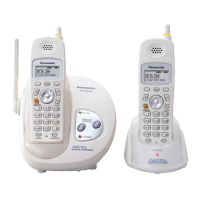
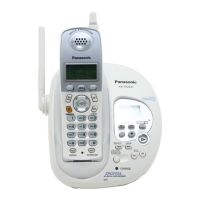

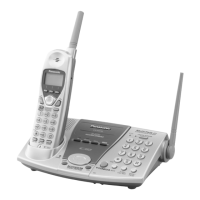
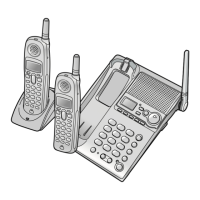
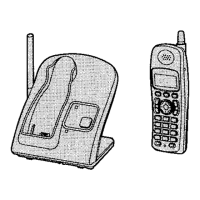

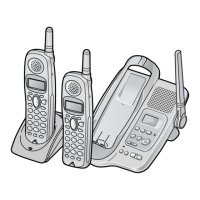

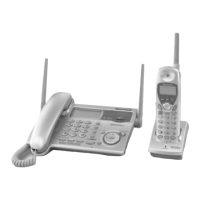
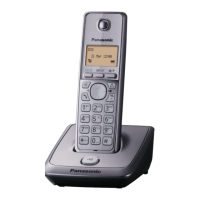
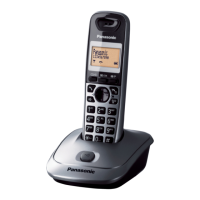
